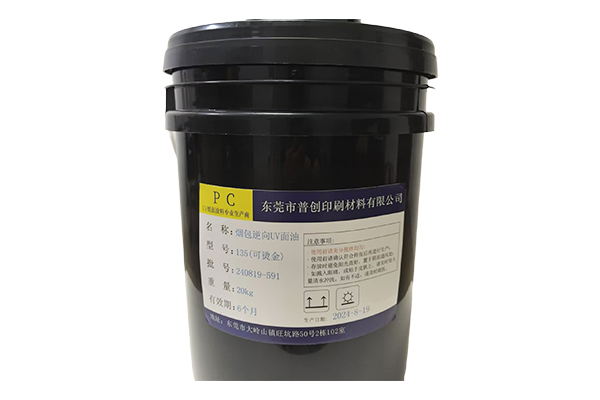What technology enhances the scratch resistance of cigarette pack reverse uv topcoat?
Release Time : 2025-09-24
Improving the scratch resistance of cigarette pack reverse UV topcoat requires a comprehensive approach encompassing material innovation, coating structure design, curing process optimization, surface modification, and composite technology integration to achieve a synergistic enhancement of both abrasion resistance and UV protection. This process not only involves a deep integration of chemical and physical mechanisms but also balances process adaptability and cost control for cigarette pack packaging.
Material modification is the core foundation for enhancing scratch resistance. Traditional cigarette pack reverse UV topcoats often utilize a single resin system, which struggles to balance hardness and toughness, making them susceptible to scratching due to friction. Incorporating nanoscale inorganic fillers (such as nanosilica and silicon carbide) into the coating through blending and modification can significantly enhance the mechanical strength of the coating. These nanoparticles form a uniformly dispersed reinforcement phase within the coating, preventing crack propagation through a "pinning effect" while also enhancing overall hardness through their high modulus. Furthermore, copolymerization with silicone or fluorocarbon resins can impart low surface energy to the coating, reducing the coefficient of friction and minimizing the likelihood of scratching. This organic-inorganic composite modification technology enables the cigarette pack reverse UV topcoat to maintain flexibility while significantly increasing its hardness and significantly enhancing its scratch resistance.
Coating structure design is crucial to optimizing performance. Reverse UV topcoats typically utilize a multi-layered composite structure. The bottom layer is an adhesion-promoting layer, ensuring a strong bond with the cigarette pack substrate. The middle layer is a UV-absorbing layer, which effectively blocks UV damage to the substrate by adding organic UV absorbers (such as benzotriazoles) or inorganic light-shielding agents (such as zinc oxide). The top layer is an abrasion-resistant protective layer, using a high-crosslinked resin or lubricating particles (such as polytetrafluoroethylene micropowder) to form a dense protective barrier. This layered design not only ensures UV protection but also enhances scratch resistance through the high hardness of the top layer. For example, using an acrylic resin with a high glass transition temperature (Tg) for the top layer effectively resists mechanical abrasion while maintaining the coating's gloss and transparency.
Optimizing the curing process directly impacts the coating's crosslinking density and microstructure. Ultraviolet (UV) curing technology is widely used in cigarette pack reverse UV topcoats due to its rapid curing, environmental friendliness, and energy-saving advantages. The curing speed and depth of the coating can be controlled by adjusting the UV lamp power, irradiation distance, and photoinitiator type. High-power UV lamps promote full curing of the coating, forming a high-density crosslinking network, improving hardness and abrasion resistance. However, overcuring can increase internal stress and cause cracking in the coating. Therefore, a staged curing process is required: a low-power pre-cure to eliminate internal stress, followed by a high-power full cure to achieve a balance between hardness and toughness. Furthermore, the addition of reactive diluents can adjust the coating's viscosity, improve leveling, and avoid weak areas caused by uneven coating.
Surface modification is an auxiliary method for improving scratch resistance. After curing, plasma treatment or chemical etching can be used to introduce micro-nanostructures to the surface, increasing surface roughness and creating a "mechanical interlocking" effect. This enhances frictional resistance between the coating and external objects and reduces the risk of scratches. At the same time, applying a hydrophobic lubricant (such as silicone oil or fluorocarbon surfactant) forms a lubricating film on the coating surface, reducing the coefficient of friction and further minimizing the visibility of scratches. For example, the surface contact angle of the Cigarette Pack Reverse UV Topcoat treated with a fluorinated lubricant can reach over 120°, simultaneously enhancing both hydrophobicity and scratch resistance.
Combining nanocoating technology with a reverse UV topcoat, using a sol-gel method to form a nanoscale silica film on the coating surface, significantly improves the coating's hardness and wear resistance. Furthermore, the introduction of self-healing materials (such as microencapsulated healing agents) allows the coating to be automatically repaired by releasing the healing agent under frictional heat when micro-scratches occur. This intelligent composite technology ensures that the Cigarette Pack Reverse UV Topcoat maintains its excellent performance over time, extending the lifespan of the packaging.
Environmental adaptability testing is a crucial step in verifying coating performance. Cigarette packs may be exposed to extreme conditions during transportation and storage, such as high temperature, high humidity, and mechanical compression. Therefore, simulation testing is required to assess the coating's weather resistance and scratch resistance. For example, a xenon lamp aging tester is used to simulate sunlight exposure, combined with a scratch tester to evaluate the coating's abrasion resistance changes after UV exposure. This ensures that the cigarette pack reverse UV topcoat maintains its excellent performance over the long term in actual use.
Improving the scratch resistance of the cigarette pack reverse UV topcoat requires the synergistic integration of multiple steps, including material modification, structural design, process optimization, surface treatment, and composite technology integration. The combined application of these technologies not only enhances the durability and aesthetics of cigarette packs, but also provides a reliable solution for the high-end packaging sector, driving the development of functional and intelligent cigarette packaging.






